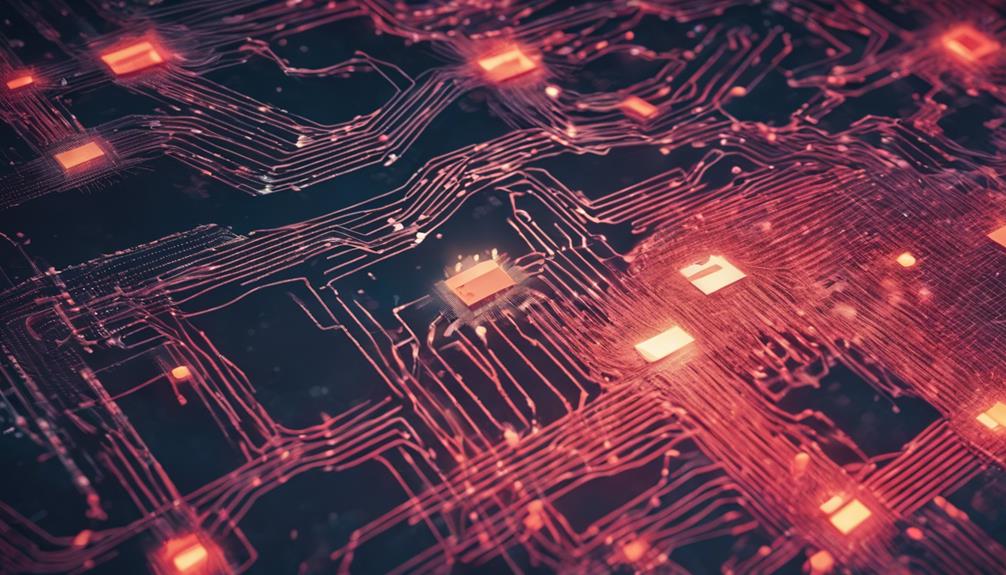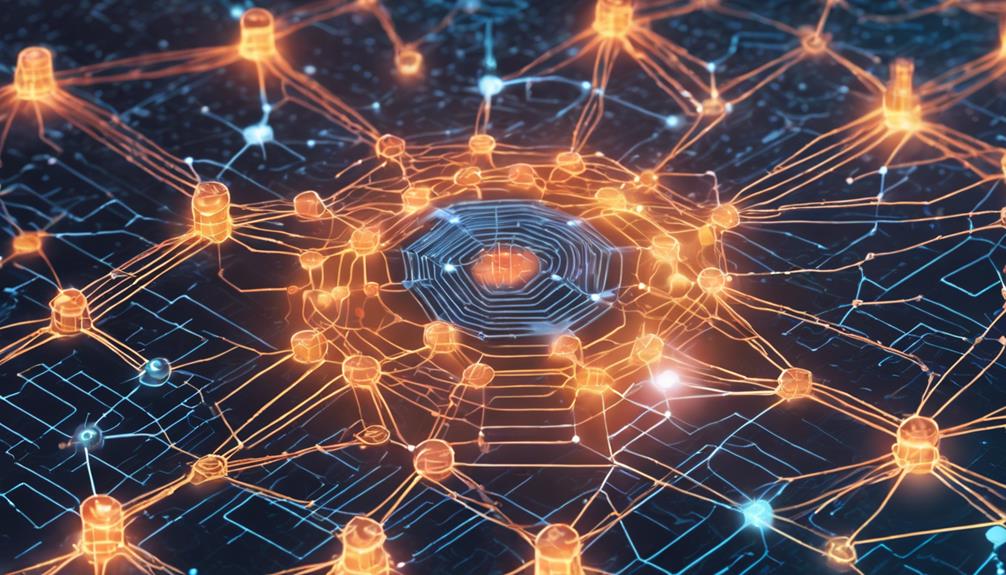Artificial Intelligence in cybersecurity offers significant benefits, but it also harbors risks. Vulnerabilities in threat detection, resource-intensive maintenance, biases in AI models, and overreliance on automation are key drawbacks. False security perceptions, evolving cyber threats, inefficient password security, and ethical/legal concerns further compound the challenges. Adverse impacts like compromised threat detection accuracy and operational strain highlight the dark side of AI in cybersecurity. Understanding these pitfalls is vital for robust cybersecurity. Embracing a thorough approach with continual evaluation and diverse security measures is essential. Further exploration reveals deeper insights into mitigating these risks.
Key Takeaways
- Vulnerabilities in AI systems can be exploited, compromising threat detection accuracy.
- Resource-intensive maintenance is required for AI implementation in cybersecurity.
- Biases in AI models impact decision-making and require ongoing monitoring.
- Overreliance on automation can introduce vulnerabilities and neglect human oversight.
- False security perceptions may arise, leading to complacency and exploitation by cybercriminals.
Vulnerabilities in Threat Detection
The vulnerabilities present in AI systems used for threat detection pose significant risks to cybersecurity defenses. Adversarial attacks, wherein attackers exploit weaknesses in AI algorithms, can compromise the accuracy of threat detection, allowing cybercriminals to bypass established security measures.
The complexity of AI systems further exacerbates these risks by harboring undetected vulnerabilities that malicious actors can leverage to their advantage.
Moreover, overreliance on AI for threat detection can lead to misleading security perceptions, potentially weakening overall cybersecurity defenses. This overreliance may result in compromised accuracy and an increased likelihood of discriminatory outcomes due to biases in AI algorithms.
Addressing these vulnerabilities requires a holistic approach that involves continual evaluation, robust testing procedures, and the implementation of diverse security measures to mitigate potential risks effectively.
Resource-Intensive Maintenance

Implementing AI in cybersecurity comes with the challenge of resource-intensive maintenance. This includes high operational costs for hardware, software, and skilled personnel, as well as the need for constant updates to keep the systems effective.
Small to mid-sized businesses may find it particularly challenging to allocate the necessary resources for maintaining AI in cybersecurity, potentially leaving them vulnerable to cyber threats.
High Operational Costs
Resource-intensive maintenance of AI systems in cybersecurity poses a significant financial burden for organizations of all sizes. While larger organizations can allocate resources to invest in cutting-edge AI technology for cybersecurity, small and mid-sized businesses often face challenges due to limited resources.
The high operational costs associated with ongoing maintenance of AI systems can strain budgets, especially for smaller entities without the financial flexibility of their larger counterparts.
Maintaining AI-powered cybersecurity solutions requires not only financial investment but also skilled personnel to guarantee effective operation. Without the necessary resources, organizations may become vulnerable to cyber threats as they struggle to sustain their AI defenses.
It is important for businesses to carefully consider the long-term financial implications of implementing AI in cybersecurity to prevent potential gaps in protection. By addressing the high operational costs proactively and seeking cost-effective solutions, organizations can better safeguard their digital assets while maximizing the benefits of AI technology.
Constant Updates Required
High operational costs associated with maintaining AI systems in cybersecurity often stem from the constant updates required to keep pace with evolving threats and vulnerabilities.
Cybersecurity systems reliant on AI algorithms demand regular updates to adapt to new attack techniques and exploits, making maintenance a resource-intensive task. Ensuring peak performance and effective threat detection capabilities necessitates meticulous attention to updating AI in cybersecurity defenses.
Failure to keep these systems up-to-date can leave organizations vulnerable to heightened security risks, emphasizing the critical need for continuous maintenance. Organizations must allocate sufficient resources towards ongoing updates and maintenance to maximize the benefits of AI in cybersecurity.
Biases in AI Models

How do biases in AI models impact decision-making processes within cybersecurity systems?
Biases in AI can arise from flaws in training data, leading to discriminatory outcomes in cybersecurity decision-making. These biases can result in certain threats being underestimated or overlooked, jeopardizing the efficacy of security measures.
When training data lacks diversity, biases can persist, influencing how AI systems categorize threats and determine response strategies. The discriminatory consequences of biased AI models can have significant real-world effects, compromising the fairness and accuracy of security protocols and incident responses.
To counter these challenges, ongoing monitoring and mitigation efforts are essential to address biases in AI models. Ensuring that cybersecurity defenses are equitable and effective requires a proactive approach to identify and rectify biases in AI systems.
Overreliance on Automation

An excessive dependence on automation in cybersecurity can introduce vulnerabilities that cybercriminals may exploit to circumvent defenses. This overreliance on AI can lead to a false sense of security, neglecting the essential need for human oversight and intervention in security processes.
To address this issue effectively, organizations must consider the following:
- Risk of Vulnerabilities: Relying solely on AI automation may result in gaps in cybersecurity defenses that cybercriminals can exploit, leading to potential breaches.
- Complacency: Organizations risk becoming complacent by assuming that AI alone can handle all security tasks without the necessary human expertise and decision-making.
- Sophisticated Attacks: Lack of human involvement in security decisions due to overreliance on automation can leave systems vulnerable to increasingly sophisticated cyber attacks.
- Balancing AI with Human Oversight: It is essential to strike a balance between AI automation and human oversight to ensure thorough protection and mitigate potential risks in cybersecurity defenses.
False Security Perceptions

Misleadingly, the reliance on AI-driven cybersecurity solutions can foster a sense of impregnability against threats, potentially blinding organizations to underlying vulnerabilities.
Overreliance on AI may lead to false security perceptions, causing a neglect of human expertise and traditional security measures. While automated security protocols offer convenience, vulnerabilities in AI systems can be exploited by cybercriminals to bypass defenses.
Autonomous AI systems, without continuous refinement, are susceptible to evolving cyber threats that can outpace their capabilities. Cyber attackers capitalize on organizations' overconfidence in AI defenses, resulting in significant security breaches and data compromises.
It is crucial for businesses to acknowledge the limitations of AI in cybersecurity and complement automated solutions with human insight and robust security practices. By understanding the risks associated with false security perceptions, organizations can fortify their defenses effectively against the ever-evolving landscape of cyber threats.
Evolving Cyber Threats

With the integration of AI technology in cybersecurity, the landscape of cyber threats is rapidly evolving, presenting new challenges for organizations. As AI continues to advance, cyber attackers are leveraging this technology to develop more sophisticated and targeted strategies. Here are some key points to take into account:
- AI-driven malware can adapt and circumvent traditional security measures, making detection more difficult.
- Phishing attacks are becoming increasingly personalized and effective with the aid of AI, leading to higher success rates in deceiving individuals.
- Automated attacks powered by AI operate with autonomy, enabling attackers to overwhelm networks at an unprecedented pace and scale.
- AI model inversion techniques, such as data poisoning, can result in biased AI decisions, compromising the integrity and reliability of cybersecurity systems.
Organizations must adapt their cybersecurity measures to combat these evolving threats effectively, staying vigilant against targeted attacks and diligently addressing detection challenges posed by AI-driven cyber threats.
Inefficient Password Security

How does inefficient password security contribute to the prevalence of breaches in cybersecurity today?
Weak passwords and poor password hygiene are significant factors leading to data breaches. Studies show that 80% of hacking-related breaches stem from weak or stolen passwords.
Despite the integration of AI in cybersecurity, challenges persist, with 65% of individuals reusing passwords across different accounts. Enforcing strong password policies remains a challenge, as 59% of employees use the same password for work and personal accounts.
Additionally, AI may not effectively address password hygiene issues, as indicated by 51% of users using identical passwords for multiple websites. This lack of attention to password security is alarming, considering that 61% of individuals have not updated their passwords in over a year.
To combat these cybersecurity challenges, it is essential for organizations and individuals to prioritize password security, implement strong password policies, and avoid password reuse to mitigate the risk of data breaches.
Ethical and Legal Concerns

What ethical and legal considerations arise from the integration of AI in cybersecurity operations?
When delving into the domain of AI in cybersecurity, several key issues come to light:
- Accountability and Transparency:
With AI making autonomous decisions, questions of who is accountable for its actions and ensuring transparency in decision-making processes become paramount.
- Legal Challenges:
Determining liability for AI-generated decisions in cases of cybersecurity breaches or data privacy violations presents a significant legal challenge.
- Data Privacy:
Concerns about privacy infringement and the ethical use of personal information arise due to AI's capability to analyze vast amounts of data.
- Bias and Discrimination:
The presence of bias in AI algorithms can lead to discriminatory outcomes in cybersecurity practices, emphasizing the importance of addressing bias to ensure fair and unbiased cybersecurity operations.
Ensuring responsible and lawful use of AI in cybersecurity operations involves navigating these ethical and legal challenges while prioritizing privacy concerns and aiming for transparency and accountability in decision-making processes.
Frequently Asked Questions
What Are the Drawbacks of AI in Cyber Security?
AI in cybersecurity, while powerful, has drawbacks. Challenges include adversarial attacks, explainability issues in deep learning models, data privacy concerns, potential complacency from overreliance, and the importance of regulatory compliance like GDPR for safeguarding data.
What Are the Disadvantages of AI Automation?
In a paradoxical twist of technology, the drawbacks of AI automation surface through potential adversarial attacks, opacity in decision-making, privacy vulnerabilities, human complacency, and regulatory challenges. Balancing innovation with security remains a delicate dance.
What Are the Risks of Artificial Intelligence in Cybersecurity?
Artificial intelligence in cybersecurity presents risks such as the creation of polymorphic malware, personalized phishing attacks, and autonomous AI-driven automated attacks that can overwhelm networks. Additionally, AI model inversion and privacy concerns with surveillance systems require meticulous security measures.
What Is the Dark Side of Artificial Intelligence?
The dark side of artificial intelligence lies in its potential for misuse and manipulation. From AI-driven malware evading defenses to autonomous attacks overwhelming networks, the power of automation can be harnessed for malicious intent, posing significant cybersecurity risks.
Conclusion
To sum up, the drawbacks of AI in cybersecurity underscore the vital risks associated with automation in safeguarding digital assets. Despite its benefits, AI can introduce vulnerabilities, biases, and false security perceptions that may compromise overall cybersecurity efforts. It is essential for organizations to carefully consider the limitations of AI and implement complementary security measures to mitigate these risks effectively.
An interesting statistic from IBM reveals that the average cost of a data breach globally is $3.86 million, underscoring the significant financial impact of cybersecurity incidents. This statistic serves as a stark reminder of the importance of addressing the potential drawbacks of AI in cybersecurity to prevent costly breaches and protect sensitive information.









